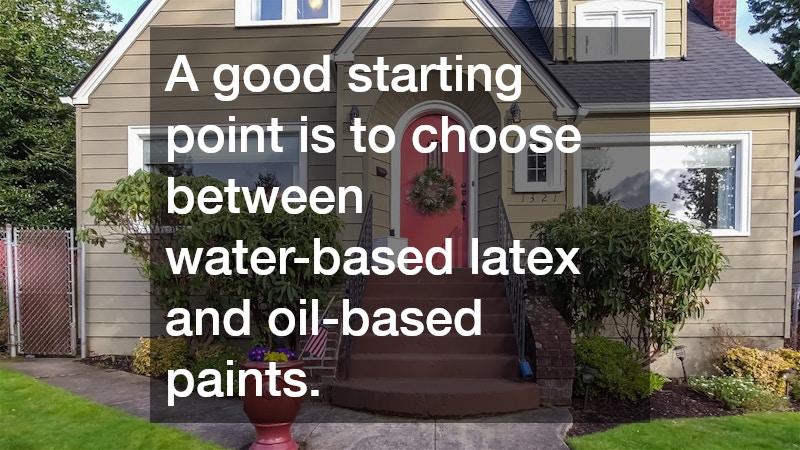Selecting the correct type of paint is crucial for the longevity and appearance of your home’s exterior. When starting this project, it’s essential to visit reputable exterior paint stores to explore your options. Exterior paints are formulated to withstand weather and environmental stresses, so it’s crucial to choose one that fits your home’s climate and material.
A good starting point is to choose between water-based latex and oil-based paints. Latex paints are commonly favored for their easy cleanup and quick drying time. They also have excellent color retention and flexibility, allowing them to expand and contract with siding without cracking. On the other hand, oil-based paints provide a durable finish and are known for their rich shine and smooth application. The choice largely depends on your specific needs and personal preference.
When assessing your options at exterior paint stores, consider the finish and color that will best suit your home’s style and environment. Matte finishes are excellent for camouflaging imperfections, while glossy paint can highlight architectural features. It’s also wise to pick a color that complements your home’s design and neighborhood. Neutral tones can offer timeless appeal, whereas bold colors might give your home a unique flair. Spending time in the store to gather samples or consult with paint experts can provide valuable insights.
Preparing the Exterior Surface
Preparation is key to ensuring your paint job lasts for many years. Start by thoroughly cleaning the surface to remove dirt, dust, and mildew. Power washing can be an effective method for cleaning siding, but care must be taken not to damage the surface with too much pressure. If your home has chipping paint, stripping or sanding these areas will be necessary before applying new paint.
Inspect the exterior for any damaged areas that need repair, such as rotten wood or cracked siding. Repairing these spots will not only help the paint adhere better but also prevent further damage down the line. Patching holes, caulking gaps, and replacing damaged boards or shingles create a smooth, even surface that enhances the finish of your new coat of paint.
Depending on the initial condition of the surface, you may need to apply a primer before painting. Primer helps the paint stick to the surface better and improves its durability. It’s particularly necessary if you are painting over dark colors, using lighter shades, or painting new, unpainted surfaces. Investing time in proper surface preparation equates to durable, professional-looking results that can increase your home’s curb appeal and value.
Applying the Paint Effectively
With the preparatory steps out of the way, it’s time to start painting. A key tip is to choose the right tools; brushes, rollers, or sprayers each suit different tasks. Brushes allow precision on edges and corners, rollers are effective for large surface areas, and sprayers can provide a smooth finish quickly on broader surfaces. Consider blending tools for a seamless application.
Begin by painting on a moderate weather day to ensure the best conditions for application and drying. Extreme heat or cold, along with humidity variations, can affect how paint dries and adheres. When painting, use long, even strokes to maintain consistency across surfaces and minimize imperfections. Always follow the manufacturer’s recommendations regarding coverage and application techniques.
It’s also vital to apply multiple coats to achieve the richest color and optimal protection. Allow ample drying time between coats to prevent smudging or paint bubbles. Using high-quality paint can reduce the number of coats needed and improve your home’s exterior aesthetics. As you finish, peel off any painter’s tape while the final coat is still wet to avoid chipping. Proper technique ensures that your paint job looks professional and lasts longer.
Finishing Touches and Maintenance
Once the painting is complete, add finishing touches to make your home’s exterior stand out. Retouch any spots where paint might have dripped or smudged. Alongside this, consider adding or updating decorative elements like shutters, flower boxes, or doors to complement your new paint job. These additions can significantly enhance the overall look and feel of your home.
Regular maintenance will preserve the appearance and integrity of your exterior paint. Clean the surface yearly to remove dirt and grime, which can prematurely age your paint. It’s also important to inspect your paint for signs of wear, such as fading, blotching, and peeling. Timely touch-ups can prevent minor issues from becoming significant problems. Consistent care extends the life of your paint job, saving you time and money in the long run.
By following these steps, you can ensure your home’s exterior stands up to the elements while looking fresh and vibrant. Engaging with knowledgeable staff at exterior paint stores can help you keep your home in top-notch condition. Ultimately, investing in quality materials and proper techniques grants you not only a beautiful home but also peace of mind knowing your investment is protected. Remember, a successful paint job is as much about preparation and maintenance as it is about application.

